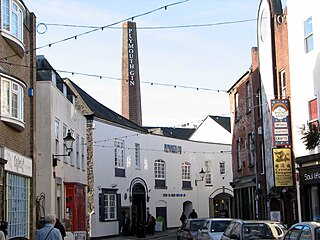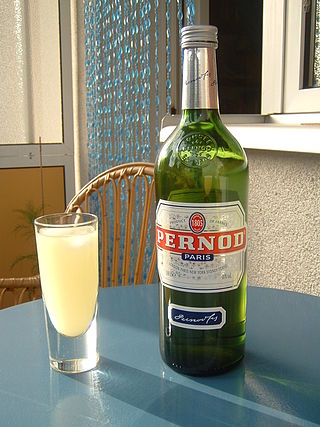
Bombay Sapphire is a brand of gin that is distilled by the Bombay Spirits Company, a subsidiary company of Bacardi, at Laverstoke Mill in the village of Laverstoke in the English county of Hampshire.

Gin is a distilled alcoholic drink flavoured with juniper berries and other botanical ingredients.

Wyborowa or Wódka Wyborowa is a brand of Polish vodka. The adjective was used in a favorable press article and then added after the word wódka 'vodka', resulting in the final name Wódka Wyborowa.

The Glenlivet distillery is a Speyside single malt Scotch whisky distillery near Ballindalloch in Moray, Scotland, that produces single malt Scotch whisky. It is the oldest legal distillery in the Highlands of Scotland. It was founded in 1824 and has operated almost continuously since.

The Plymouth Gin Distillery is a gin manufacturer on The Barbican, Plymouth, England. Also known as the Black Friars Distillery, it is the only gin distillery in the city. The original building opens on to what is now Southside Street. Established in 1793, it is the oldest operating distillery in Britain.

Pernod is an absinthe produced by Pernod Ricard released in 2005 based on the original Pernod Fils recipe.

Pernod Ricard is a French company best known for its anise-flavoured pastis apéritifs Pernod Anise and Ricard Pastis. The world's second-largest wine and spirits seller, it also produces several other types of pastis.
Tanqueray is a brand of gin produced by Diageo plc. It originated in London. While it does not command a sizable market share in its native market, its largest market is the US.

Gordon's is a brand of London dry gin first produced in 1769. The top markets for Gordon's are the United Kingdom, the United States and Greece. It is owned by the British spirits company Diageo. It is the world's best-selling London dry gin. Gordon's has been the UK's number one gin since the late 19th century. A 40% ABV version for the North American market is distilled in Canada.

Beefeater Gin is a brand of gin owned by Pernod Ricard and bottled and distributed in the United Kingdom. Beefeater remained in the control of its founding Burrough family until 1987. The Beefeater distillery is one of 24 in London.

Dubonnet is a sweet, aromatised wine-based quinquina, often enjoyed as an aperitif. It is a blend of fortified wine, herbs, and spices, with fermentation being stopped by the addition of alcohol. It is currently produced in France by Pernod Ricard, and in the United States by Heaven Hill Distilleries of Bardstown, Kentucky. The French made version is 14.8% alcohol by volume and the US version 19%. The beverage is famous in the UK for having been the favourite drink of Queen Elizabeth II and Queen Elizabeth The Queen Mother.

Boodles British Gin is a brand of gin bottled and distributed in the United Kingdom by Proximo Spirits.

Corby Spirit and Wine Limited is a Canadian alcohol manufacturing and distribution company. It was founded in 1859 in Corbyville, Ontario. As of 2008, the company is 46% owned by Pernod Ricard. The company distills several Canadian specialities, as well as marketing Pernod Ricard's products in Canada. Corby is listed on the Toronto Stock Exchange under the trading symbols CSW.A and CSW.B. Corby is known for funding free travel on the TTC on New Years Eve in Toronto.

Sipsmith is a microdistillery located in London. It is the first copper-pot distillery to open within Greater London' in nearly two centuries. It has been owned by Suntory Global Spirits, a subsidiary of Suntory Holdings of Osaka, Japan, since December 2016.
Sacred Spirits is a microdistillery in Highgate, London. It distills its spirits under a vacuum in glassware, and thus at a lower temperature than traditional pot stills, which operate at atmospheric pressure. The microdistillery operates out of the back room of a residential house, with a vacuum plant in a wendy house in the distiller's back garden. It is an authorised Customs and Excise distillery.

Sazerac Company, Inc. is a privately held American alcoholic beverage company headquartered in Metairie in the metropolitan area of New Orleans, Louisiana, but with its principal office in Louisville, Kentucky. The company is owned by billionaire William Goldring and his family. As of 2017, it operated nine distilleries, had 2,000 employees, and operated in 112 countries. It is one of the two largest spirits companies in the United States, with annual revenue of about $1 billion made from selling about 300 beverage brands.
Broker’s London Dry Gin is a brand of gin micro-distilled at a 200-year-old distillery located near Birmingham, England, using a traditional copper pot still.
MGP Ingredients, Inc. is an American distilled spirits and food ingredients producer with headquarters in Atchison, Kansas.

Tōkki Soju is a brand of soju founded in Brooklyn, New York in 2016 by master distiller Brandon Hill. The company prides themselves on quality over profit, using expensive ingredients that contribute to taste such as glutinous rice.
Malfy Gin is a brand of gin bottled in Italy, distilled by Torino Distillati, and distributed by Pernod Ricard.


















